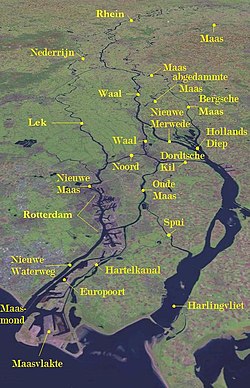Distributary
This article needs additional citations for verification. (May 2014) |

A distributary, or a distributary channel, is a stream that branches off and flows away from a main stream channel, a phenomenon known as river bifurcation. A distributary is effectively the opposite of a tributary, which is a stream that flows towards and into another stream or river. Distributaries are often found where a river approaches a lake or an ocean and divides into distributary networks; as such they are a common feature of river deltas.[1] They can also occur inland, on alluvial fans, or where a tributary stream bifurcates as it nears its confluence with a larger stream. In some cases, a minor distributary can divert so much water from the main channel that it can later become the main route.
Related terms
Common terms to name individual river distributaries in English-speaking countries are arm and channel. These terms may refer to a distributary that does not rejoin the channel from which it has branched (e.g., the North, Middle, and South Arms of the Fraser River, or the West Channel of the Mackenzie River), or to one that does (e.g. Annacis Channel and Annieville Channel of the Fraser River, separated by Annacis Island).
In Australia, the term anabranch is used to refer to a distributary that diverts from the main course of the river and rejoins it later. In North America such a branching river is called a braided river.[2]
North America

In
In British Columbia, Canada, the Fraser River has numerous sloughs and side-channels which may be defined as distributaries. This river's final stretch has three main distributaries: the North Arm and the South Arm, and a few smaller ones adjoining them.
Examples of inland distributaries:
- Henrys Fork in Idaho—splits into two distributary channels, the North Fork and South Fork, which join Henrys Fork miles apart.
- North Two Ocean Creeksplits into two distributaries, Pacific Creek and Atlantic Creek, which ultimately flow into their respective oceans.
- Sierra Nevada mountains to the flat Central Valley. Distributaries flow north into the Pacific Ocean via the San Joaquin River and south into an endorheic basin surrounding Tulare Lake.
- The Qu'Appelle River, in Saskatchewan and Manitoba, is a distributary of the South Saskatchewan River. Its flow is controlled by the Qu'Appelle River Dam. This dam forms the southern arm of Lake Diefenbaker.
South America
The Casiquiare canal is an inland distributary of the upper Orinoco, which flows southward into the Rio Negro, forming a unique natural canal between the Orinoco and Amazon river systems. It is the largest river on the planet that links two major river systems.
Europe

- The IJssel, the Waal and the Nederrijn (Lower Rhine) are the three principal distributaries of the Rhine. These are formed by two separate bifurcations within the Rhine–Meuse–Scheldt delta.
- The Akhtuba River is a major distributary of the Volga. The bifurcation occurs close to, but before, the Volga Delta.
- The Tärendö River in northern Sweden is an inland distributary, far from the mouth of the river. It begins at the Torne River and ends at the Kalix River.
- The Vah before rejoining the main river near Komárno. The area in the middle is the largest freshwater island in Europe.
- The Abbey River, Limerick, in Ireland is a distributary arm of the River Shannon. It rejoins the Shannon to form an island upon which King John's Castle is built.
Asia
Eastern Asia
The
Southeast Asia
The Tha Chin River and Noi River are distributaries of the Chao Phraya River in Thailand, splitting off from the latter about 200 kilometers upstream from the Bay of Bangkok.
The Brantas River in East Java, Indonesia, branches off into two distributaries, Mas River, also known as Surabaya River, and Porong River.[4]
Indian Subcontinent

- Kaveri River.
- alluvial fans as they transition from the mountain region to the flat Indo-Gangetic Plain. These areas are highly flood-prone, for example the 2008 Bihar flood on the Kosi River.
- Padma River is the main distributary of the Ganges in Bangladesh.
- Brahmaputra complex enters the sea through Bangladesh.
- Nara River is a distributary of the Indus River.
Africa
- The Nile River has two distributaries, the Rosetta and the Damietta branches. According to Pliny the Elderit had in ancient times seven distributaries (east to west):
- The Pelusiac
- The Tanitic
- The Mendesian
- The Phatnitic
- The Sebennytic
- The Bolbitine
- The Canopic
- The Okavango River ends in many distributaries in a large inland delta called the Okavango Delta. It is an example of distributaries that do not flow into any other body of water.
Oceania

Australia
A number of the rivers that flow inland from Australia's
Papua New Guinea
Many of Papua New Guinea's major rivers flow into the Gulf of Papua through marshy, low-lying country, allowing for wide, many-branched deltas. These include the Fly River, which splits into three major and several minor rivers close to its mouth. The Bamu River splits into several channels close to its mouth, among them the Bebea, Bina, Dibiri, and Aramia. The Kikori River also splits into a multitude of channels as it crosses the plains close to the Gulf of Papua. The Purari River splits into three major channels as it approaches its mouth.
New Zealand
New Zealand's second-longest river, the
References
- .
- S2CID 129232374.
- ^ John McPhee, The Control of Nature
- ^ Valiant, Raymond (2014). TANTANGAN DALAM PENGELOLAAN SUMBERDAYA AIR UNTUK MENCAPAI LINGKUNGAN LESTARI BERKELANJUTAN: POTRET DAERAH ALIRAN SUNGAI (DAS) BRANTAS. Seminar Pekan DAS Brantas 2014. Fakultas Teknik Universitas Brawijaya Malang. Retrieved 28 March 2024.
Citations
- Olariu, Cornel; Bhattacharya, Janok P. (2006). "Terminal Distributary Channels and Delta Front Architecture of River-Dominated Delta Systems" (PDF). Journal of Sedimentary Research. 76 (2). Society for Sedimentary Geology: 212–233. doi:10.2110/jsr.2006.026. Archived from the original(PDF) on December 23, 2015. Retrieved December 10, 2013.
